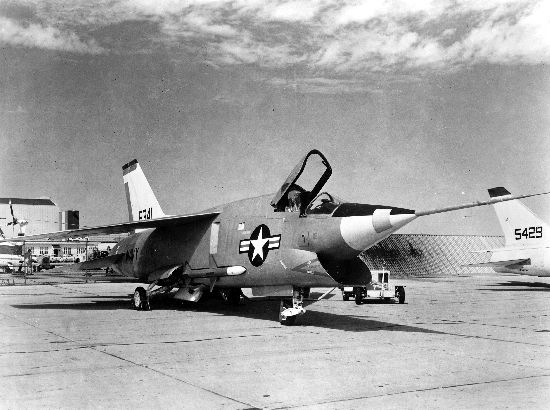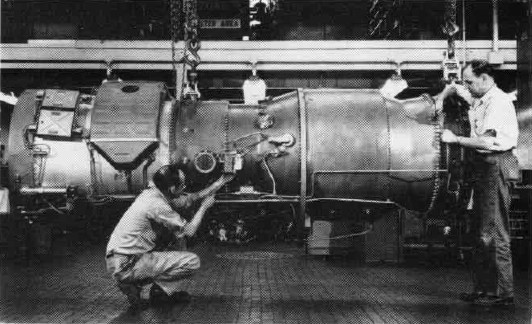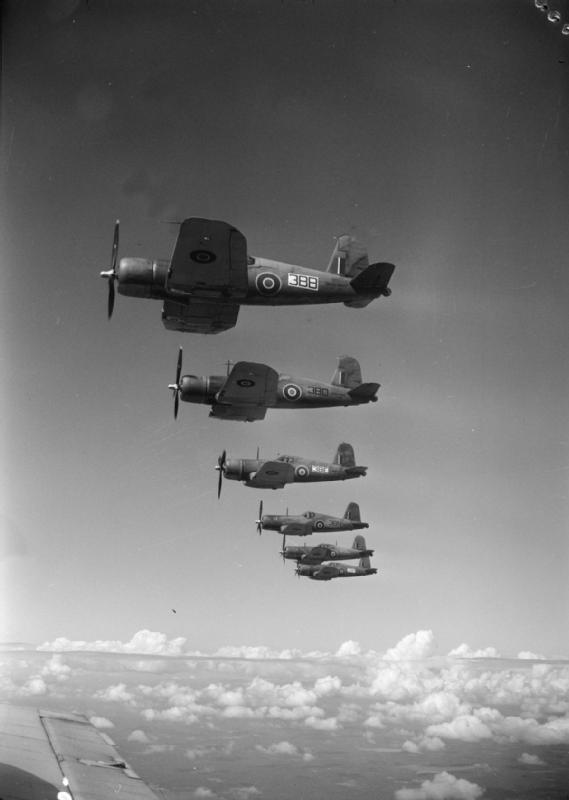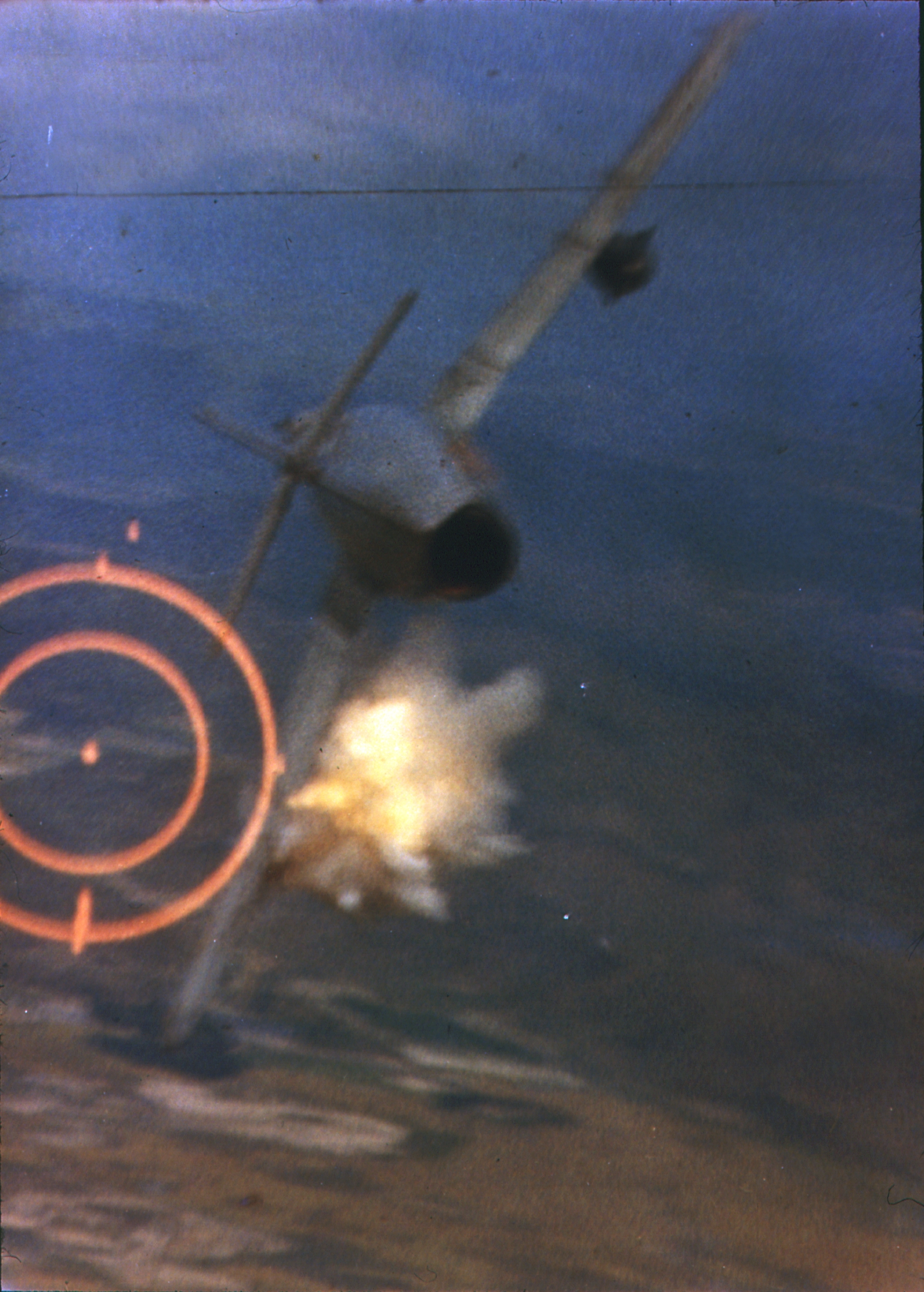|
XF8U-3
The Vought XF8U-3 Crusader III was an aircraft developed by Chance Vought as a successor to the successful Vought F-8 Crusader program and as a competitor to the McDonnell Douglas F-4 Phantom II.Tillman 1990 Though based in spirit on the F8U-1 and F8U-2, and sharing the older aircraft's designation in the old Navy system, the two aircraft shared few parts. Design and development In parallel with the F8U-1s and -2s, the Crusader design team was also working on a larger aircraft with better performance, designated within Vought as the V-401. Although externally similar to the Crusader and sharing with it the variable incidence wing, the Crusader III was larger and was powered by the Pratt & Whitney J75-P-5A engine generating 29,500 lbf (131 kN) of afterburning thrust. The Crusader III was designed for brief excursions to Mach 2.7 and two visible features showed it had a speed capability beyond that of the earlier Crusaders, namely a swept-forward "scoop" air inlet for t ... [...More Info...] [...Related Items...] OR: [Wikipedia] [Google] [Baidu] |
Vought F-8 Crusader
The Vought F-8 Crusader (originally F8U) is a single-engine, supersonic, carrier-based air superiority jet aircraft built by Vought for the United States Navy and United States Marine Corps (replacing the Vought F7U Cutlass), and for the French Navy. The first F-8 prototype was ready for flight in February 1955. The F-8 served principally in the Vietnam War. The Crusader was the last American fighter with guns as the primary weapon, earning it the title "The Last of the Gunfighters".Tillman 1990 The RF-8 Crusader was a photo-reconnaissance development and operated longer in U.S. service than any of the fighter versions. RF-8s played a crucial role in the Cuban Missile Crisis, providing essential low-level photographs impossible to acquire by other means. United States Navy Reserve units continued to operate the RF-8 until 1987. Design and development In September 1952, the United States Navy announced a requirement for a new fighter. It was to have a top speed of Mach 1.2 ... [...More Info...] [...Related Items...] OR: [Wikipedia] [Google] [Baidu] |
Pratt & Whitney J75
The Pratt & Whitney J75 (civilian designation: JT4A) is an axial-flow turbojet engine first flown in 1955. A two-spool design in the 17,000 lbf (76 kN) thrust class, the J75 was essentially the bigger brother of the Pratt & Whitney J57 (JT3C). It was known in civilian service as the JT4A, and in a variety of stationary roles as the GG4 and FT4. Design and development In military use, the J75 was used on the Convair F-106 Delta Dart, Lockheed U-2, and Republic F-105 Thunderchief. It was also utilized in the prototype and experimental Avro Canada CF-105 Arrow, Lockheed A-12, Martin P6M SeaMaster, North American YF-107, and Vought XF8U-3 Crusader III. Before the arrival of the Pratt & Whitney JT3D turbofan engine, the JT4A was used to power certain Boeing 707 and Douglas DC-8 models, bringing improved field performance in the medium-range Boeing 707-220 and Douglas DC-8-20, and intercontinental range in the Boeing 707-320 and the Douglas DC-8-30. By late 1959, P&W had ... [...More Info...] [...Related Items...] OR: [Wikipedia] [Google] [Baidu] |
Grumman G-118
__NOTOC__ The Grumman G-118 (sometimes called the XF12F, though this was never officialButtler p. 126) was a design for an all-weather missile-armed interceptor aircraft for use on US Navy aircraft carriers. Originally conceived as an uprated F11F Tiger, it soon evolved into a larger and more powerful project. Although two prototypes were ordered in 1955, development was cancelled the same year in favor of the F4H Phantom II before any examples were built. Grumman's next (and last) carrier fighter would be the F-14 Tomcat, ordered in 1968. Design The Grumman Design 118 was a two-seat, twin-engined, rocket augmented, carrier-based all-weather supersonic fighter aircraft. It had a 45° swept wing, a "T-tail" empennage, two small folding ventral fins, and a landing gear of tricycle configuration. For ejection, the tandem crew were encapsulated and ejected downwards. It also featured a boundary layer control system to improve low speed handling. The G-118 was to be powered ... [...More Info...] [...Related Items...] OR: [Wikipedia] [Google] [Baidu] |
McDonnell Douglas F-4 Phantom II
The McDonnell Douglas F-4 Phantom II is an American tandem two-seat, twin-engine, all-weather, long-range supersonic jet interceptor and fighter-bomber originally developed by McDonnell Aircraft for the United States Navy.Swanborough and Bowers 1976, p. 301. Proving highly adaptable, it entered service with the Navy in 1961 before it was adopted by the United States Marine Corps and the United States Air Force, and by the mid-1960s it had become a major part of their air arms. Phantom production ran from 1958 to 1981 with a total of 5,195 aircraft built, making it the most produced American supersonic military aircraft in history, and cementing its position as an iconic combat aircraft of the Cold War."F-4 Phantoms Phabulous 40th" Boeing. Retrieved : 27 November 2012. [...More Info...] [...Related Items...] OR: [Wikipedia] [Google] [Baidu] |
List Of Fighter Aircraft
This is a list of military aircraft that are primarily designed for air-to-air combat and thus does not include aircraft intended for other roles where they have some secondary air-to-air capability, such as with many ground attack aircraft. The list does not include projects that were cancelled before an aircraft was built or fictional aircraft. List , - , ACAZ C.2, , Belgium, , Two-seat fighter, , 1926, , Prototype, , , , , - , Adamoli-Cattani fighter, , Italy, , , , 1918, , Prototype, , , , , - , AD Scout, , UK, , Zeppelin interceptor, , 1915, , Prototype, , , , , - , AEG D.I, D.II & D.III, , Germany, , , , 1917, , Prototype, , , , , - , AEG Dr.I, , Germany, , , , 1917, , Prototype, , , , , - , Aerfer Ariete, , Italy, , , , 1958, , Prototype, , , , , - , Aerfer Sagittario 2, , Italy, , Lightweight fighter, , 1956, , Prototype, , , , , - , Aero Ae 02, , Czechoslovakia, , , , 1920, , Prototype, , , , , - , Aero Ae 04, , Czechoslovakia, , , , 1921, , Prototype, , , ... [...More Info...] [...Related Items...] OR: [Wikipedia] [Google] [Baidu] |
Vought
Vought was the name of several related American aerospace firms. These have included, in the past, Lewis and Vought Corporation, Chance Vought, Vought-Sikorsky, LTV Aerospace (part of Ling-Temco-Vought), Vought Aircraft Companies, and Vought Aircraft Industries. The first incarnation of Vought was established by Chance M. Vought and Birdseye Lewis in 1917. In 1928, it was acquired by United Aircraft and Transport Corporation, which a few years later became United Aircraft Corporation; this was the first of many reorganizations and buyouts. During the 1920s and 1930s, Vought Aircraft and Chance Vought specialized in carrier-based aircraft for the United States Navy, by far its biggest customer. Chance Vought produced thousands of planes during World War II, including the F4U Corsair. Vought became independent again in 1954, and was purchased by Ling-Temco-Vought (LTV) in 1961. The company designed and produced a variety of planes and missiles throughout the Cold War. Vought ... [...More Info...] [...Related Items...] OR: [Wikipedia] [Google] [Baidu] |
Vought F8U-3 Crusader III Side View PD
Vought was the name of several related American aerospace firms. These have included, in the past, Lewis and Vought Corporation, Chance Vought, Vought-Sikorsky, LTV Aerospace (part of Ling-Temco-Vought), Vought Aircraft Companies, and Vought Aircraft Industries. The first incarnation of Vought was established by Chance M. Vought and Birdseye Lewis in 1917. In 1928, it was acquired by United Aircraft and Transport Corporation, which a few years later became United Aircraft Corporation; this was the first of many reorganizations and buyouts. During the 1920s and 1930s, Vought Aircraft and Chance Vought specialized in carrier-based aircraft for the United States Navy, by far its biggest customer. Chance Vought produced thousands of planes during World War II, including the F4U Corsair. Vought became independent again in 1954, and was purchased by Ling-Temco-Vought (LTV) in 1961. The company designed and produced a variety of planes and missiles throughout the Cold War. Vought was ... [...More Info...] [...Related Items...] OR: [Wikipedia] [Google] [Baidu] |
Turbojet
The turbojet is an airbreathing jet engine which is typically used in aircraft. It consists of a gas turbine with a propelling nozzle. The gas turbine has an air inlet which includes inlet guide vanes, a compressor, a combustion chamber, and a turbine (that drives the compressor). The compressed air from the compressor is heated by burning fuel in the combustion chamber and then allowed to expand through the turbine. The turbine exhaust is then expanded in the propelling nozzle where it is accelerated to high speed to provide thrust. Two engineers, Frank Whittle in the United Kingdom and Hans von Ohain in Germany, developed the concept independently into practical engines during the late 1930s. Turbojets have poor efficiency at low vehicle speeds, which limits their usefulness in vehicles other than aircraft. Turbojet engines have been used in isolated cases to power vehicles other than aircraft, typically for attempts on land speed records. Where vehicles are "turbine ... [...More Info...] [...Related Items...] OR: [Wikipedia] [Google] [Baidu] |
Dogfight
A dogfight, or dog fight, is an aerial battle between fighter aircraft conducted at close range. Dogfighting first occurred in Mexico in 1913, shortly after the invention of the airplane. Until at least 1992, it was a component in every major war, though with steadily declining frequency. Since then, longer-range weapons have made dogfighting largely obsolete. Modern terminology for air-to-air combat is air combat maneuvering (ACM), which refers to tactical situations requiring the use of individual basic fighter maneuvers (BFM) to attack or evade one or more opponents. This differs from aerial warfare, which deals with the strategy involved in planning and executing various missions. Etymology The term ''dogfight'' has been used for centuries to describe a melee: a fierce, fast-paced close quarters battle between two or more opponents. The term gained popularity during World War II, although its origin in air combat can be traced to the latter years of World War I. One o ... [...More Info...] [...Related Items...] OR: [Wikipedia] [Google] [Baidu] |
US Gal
The gallon is a unit of volume in imperial units and United States customary units. Three different versions are in current use: *the imperial gallon (imp gal), defined as , which is or was used in the United Kingdom, Ireland, Canada, Australia, New Zealand, and some Caribbean countries; *the US gallon (US gal), defined as , (231 cubic inches) which is used in the US and some Latin American and Caribbean countries; and *the US dry gallon ("usdrygal"), defined as US bushel (exactly ). There are two pints in a quart and four quarts in a gallon. Different sizes of pints account for the different sizes of the imperial and US gallons. The IEEE standard symbol for both US (liquid) and imperial gallon is gal, not to be confused with the gal (symbol: Gal), a CGS unit of acceleration. Definitions The gallon currently has one definition in the imperial system, and two definitions (liquid and dry) in the US customary system. Historically, there were many definitions and redefinit ... [...More Info...] [...Related Items...] OR: [Wikipedia] [Google] [Baidu] |
WikiProject Aircraft
A WikiProject, or Wikiproject, is a Wikimedia movement affinity group for contributors with shared goals. WikiProjects are prevalent within the largest wiki, Wikipedia, and exist to varying degrees within Wikimedia project, sister projects such as Wiktionary, Wikiquote, Wikidata, and Wikisource. They also exist in different languages, and translation of articles is a form of their collaboration. During the COVID-19 pandemic, CBS News noted the role of Wikipedia's WikiProject Medicine in maintaining the accuracy of articles related to the disease. Another WikiProject that has drawn attention is WikiProject Women Scientists, which was profiled by ''Smithsonian Magazine, Smithsonian'' for its efforts to improve coverage of women scientists which the profile noted had "helped increase the number of female scientists on Wikipedia from around 1,600 to over 5,000". On Wikipedia Some Wikipedia WikiProjects are substantial enough to engage in cooperative activities with outside organization ... [...More Info...] [...Related Items...] OR: [Wikipedia] [Google] [Baidu] |








